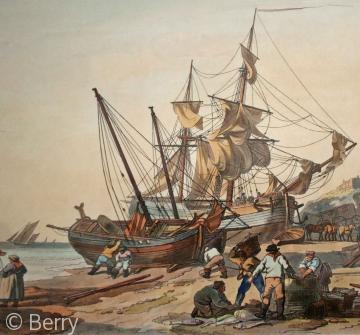Declining coastal towns become seaside resorts - the case of Brighton

Most places have two histories, the actual and the mythical. Some myths become so well-established that they overshadow the history of a place. One of the most pervasive myths about Brighton is that it was a poor fishing village until (depending on the source), either Dr. Richard Russell or George, Prince of Wales arrived here and singlehandedly turned it in to a fashionable resort. This myth started during the 1770s when Dr Russell was credited with this transformation. Some sources then refer to the Duke of Cumberland as the saviour of Brighton. From the 1780s, the Prince of Wales was usually indentified as the accidental promoter of Brighton’s transformation. These stories, mostly promoted in guide books, overstate the role of these men and obscure a very important fact about Brighton which explains why it and not, for example Rottingdean just eastwards along the coast, became a seaside resort in the 1750s and 1760s.
Crucially, Brighton was a small town with basic shops, a lot of cheap accommodation and high unemployment. For a short period in the mid to later seventeenth century, it was probably the largest town in Sussex, with a population of perhaps 4,000. The town’s economy depended on long distance fishing, particularly for herring in the North Sea. The fishing industry collapsed for a variety of reasons between about 1670 and 1700. Competition from larger fishing vessels in the herring industry in the North Sea, the acceleration of the coastal erosion that bedevilled the town right into the later 1700s were but two, This town’s decline was accelerated by the loss of the long distance coastal carrying trade.
All of the other early resorts; Hastings, Margate, Scarborough and Weymouth were also small coastal towns which needed new sources of employment. Why were the early resorts so similar in character? Small coastal towns had reasonable communication networks – both inland and by sea and backers who were prepared to invest in this new business. These towns normally had financial and other links with more prosperous inland centres. During the 1750s and 1760s a considerable amount of the early capital invested in the basic tourism facilities, such as libraries in Brighton, came from Lewes. Russell had a fashionable practice in Lewes. Shergold, who bought a house in Brighton and turned it into the Castle Inn, was an innkeeper from Lewes. The name of the Inn referred to the Castle in his home town.
Early resorts had very short seasons during which a few hundred people might visit. In Sanditon, her unfinished story about the development of a new resort, Jane Austen points out that trying to build a resort from new was not easy due to the capital cost of new houses, baths, assembly rooms, a library, a theatre, a chapel, a promenade and bathing machines. In old towns, the risk could be spread between many.
Between 1750 and 1780, tourism became a lifeline for the town. Had local landowners, businessmen and doctors not become supporters of the development of tourism here, then Brighton would have shrunk back to the village it had once been in the medieval period. There are many communities in Britain where this happened right into the nineteenth century. The idea of keeping declining towns alive by public subsidy is a twentieth century concept.
The growth of Brighton exerted a profound influence on all of the parishes now in the City. Rottingdean attracted visitors to sea bathe in the 1760s if not sooner. Hove supplied building materials - bricks and tiles and then space for houses. Preston had a tea garden in the 1760s. The archaeological sites in several parishes were popular to visit. The long lost Hove barrow was one. Several of the graveyards of the ancient parish churches became popular places in which to be buried. The grounds of Stanmer House just a short ride north-east of Brighton (revamped in the 1720s and the Park between the 1720s and 1800) were visited by wealthy visitors to Brighton. Some, from the 1770s, were invited to dine. The surviving guest book is a ‘who’s who’ of the period. Guests included Georgiana, Duchess of Devonshire, George Prince of Wales and many prominent Whigs. These were visiting the flourishing resort to which George Prince of Wales was attracted by its reputation and the social standing of the visitors. He did not found the resort, it has been flourishing for more than twenty years when he appeared.
Further reading – Berry, S., ‘Myth and Reality in the Representation of Resorts; Brighton and the emergence of the ‘Prince and the fishing village’ myth 1770-1824’ Sussex Archaological Collections 140 (2002) 97-112. Berry, S., Georgian Brighton (Phillimore, 2005).
Content derived from research undertaken as part of the Victoria County History project

